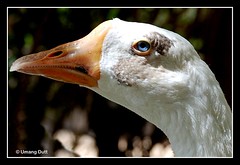The Swan Goose Anser cygnoides is a large goose with a natural breeding range in Mongolia, northernmost China, and southeastern Russia. It is migratory and winters mainly in central and eastern China. The species has been domesticated, and introduced and feral populations occur elsewhere.
It is large for its genus, 81–94 cm long (the longest Anser goose) and weighing 2.8–3.5 kg (the second-heaviest, after Greylag Goose). It has a long neck, long, heavy black bill, brown cap and pale underparts apart from some belly streaking; the upperparts are brown and the legs are orange. The sexes are similar, although the male is larger, and juveniles are duller. The voice is a loud honking. It grazes on sedges, and rarely swims. It forms small flocks outside the breeding season.
It is a rare goose of steppes and mountain valleys, which breeds near marshes and other wetlands, laying 5–8 eggs in a ground nest. In the winter it grazes on steppes and stubble, sometimes far from water.
The Swan Goose is extensively kept as poultry. A large number of breeds have been selected in captivity, known as Chinese goose (another heavier breed is known as the African goose, differing from the wild birds in much larger size (up to 5-10 kg in males, 4-9 kg in females), and in having an often strongly developed basal knob on the upper side of the bill. Some domesticated, introduced, or feral populations may be completely white, while others retain a plumage pattern more like wild birds. The knob at the top of the beak is more prominent on males than females. By 6–8 weeks of age, the knob is already pronounced enough that it can be used for sexing. A female Chinese goose can lay 50–60 eggs over the course of the breeding season (February to June), although there are reports of Chinese geese laying up to 100 eggs during that time.
"The hybrids from the common and Chinese geese (A. cygnoides), species which are so different that they are generally ranked in distinct genera, have often bred in this country with either pure parent, and in one single instance they have bred inter se." Charles Darwin, The Origin of Species, Penguin Classics



No comments:
Post a Comment